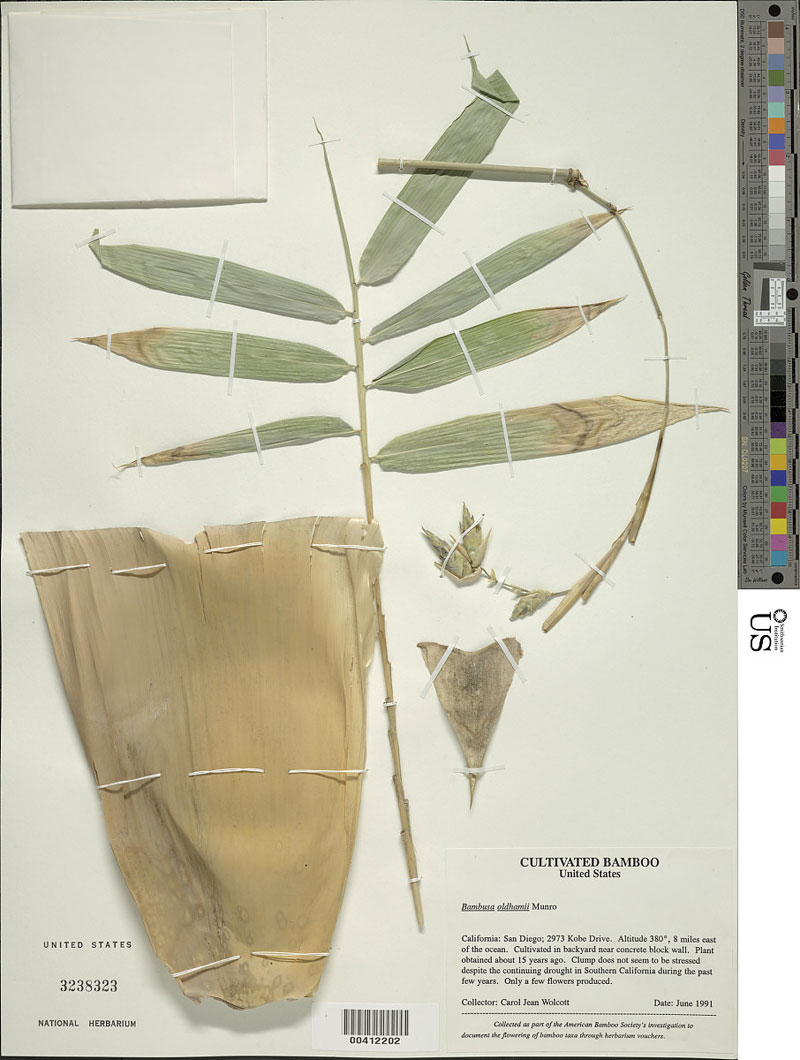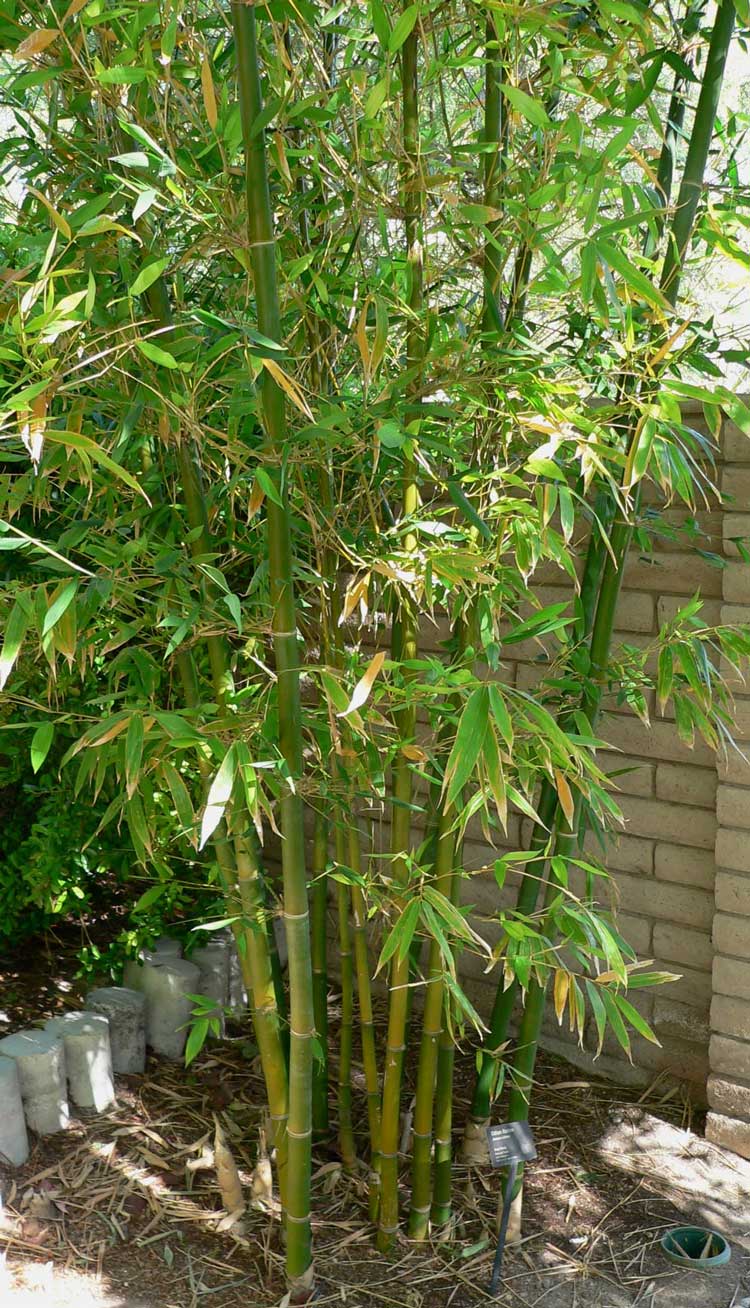
Classification System: APG IV
Superregnum: Eukaryota
Regnum: Plantae
Cladus: Angiosperms
Cladus: Monocots
Cladus: Commelinids
Ordo: Poales
Familia: Poaceae
Subfamilia: Bambusoideae
Tribus: Bambuseae
Subtribus: Bambusinae
Genus: Bambusa
Species: Bambusa oldhamii
Name
Bambusa oldhamii Munro, 1868
Synonyms
Homotypic
Arundarbor oldhamii (Munro) Kuntze, Revis. Gen. Pl. 2: 761 (1891).
Leleba oldhamii (Munro) Nakai, J. Jap. Bot. 9: 16 (1933).
Sinocalamus oldhamii (Munro) McClure, Lingnan Univ. Sci. Bull. 9: 67 (1940).
Dendrocalamopsis oldhamii (Munro) Keng f., J. Bamboo Res. 2(1): 12 (1983).
Heterotypic
Bambusa atrovirens T.H.Wen, J. Bamboo Res. 5(2): 15 (1986).
Bambusa oldhamii f. revoluta W.T.Lin & J.Y.Lin, Acta Phytotax. Sin. 26: 225 (1988).
Dendrocalamopsis atrovirens (T.H.Wen) Keng f. ex W.T.Lin, Guihaia 10: 15 (1990).
Dendrocalamopsis oldhamii f. revoluta (W.T.Lin & J.Y.Lin) W.T.Lin, Guihaia 10: 15 (1990).
Neosinocalamus revolutus (W.T.Lin & J.Y.Lin) T.H.Wen, J. Bamboo Res. 10(1): 23 (1991).
Sinocalamus oldhamii f. revolutus (W.T.Lin & J.Y.Lin) W.T.Lin, J. S. China Agric. Univ. 14(3): 111 (1993).
Bambusa revoluta (W.T.Lin & J.Y.Lin) N.H.Xia, R.H.Wang & R.S.Lin, J. Trop. Subtrop. Bot. 17: 352 (2009).
Distribution
Native distribution areas:
Continental: Asia-Temperate
China
China Southeast, Hainan
Introduced into:
giant timber bamboo, Oldham's bambooColombia, Ecuador, Honduras, Mexico Southeast, Nansei-shoto, New Zealand North, Peru, Puerto Rico, Taiwan
References: Brummitt, R.K. 2001. TDWG – World Geographical Scheme for Recording Plant Distributions, 2nd Edition

Bambusa oldhamii (*)
References
Primary references
Munro, W., 1993. Transactions of the Linnean Society of London. London 26: 109 (1868)
Additional references
Clayton, W.D., Harman, K.T. & Williamson, H. (2006). World Grass Species - Synonymy database The Board of Trustees of the Royal Botanic Gardens, Kew.
Links
Govaerts, R. et al. 2022. Bambusa oldhamii in Kew Science Plants of the World online. The Board of Trustees of the Royal Botanic Gardens, Kew. Published online. Accessed: 2022 August 21. Reference page.
Hassler, M. 2022. Bambusa oldhamii. World Plants: Synonymic Checklists of the Vascular Plants of the World In: Roskovh, Y., Abucay, L., Orrell, T., Nicolson, D., Bailly, N., Kirk, P., Bourgoin, T., DeWalt, R.E., Decock, W., De Wever, A., Nieukerken, E. van, Zarucchi, J. & Penev, L., eds. 2022. Species 2000 & ITIS Catalogue of Life. Published online. Accessed: 2022 August 21. Reference page.
Tropicos.org 2022. Bambusa oldhamii. Missouri Botanical Garden. Published online. Accessed: 21 August 2022.
International Plant Names Index. 2022. Bambusa oldhamii. Published online. Accessed: August 21 2022.
USDA, ARS, Germplasm Resources Information Network. Bambusa oldhamii in the Germplasm Resources Information Network (GRIN), U.S. Department of Agriculture Agricultural Research Service. Accessed: 2022 August 21.
Vernacular names
English: giant timber bamboo, Oldham's bamboo
Bambusa oldhamii, known as giant timber bamboo or Oldham's bamboo, is a large species of bamboo. It is the most common and widely grown bamboo in the United States and has been introduced into cultivation around the world. It is densely foliated, growing up to 20 metres (65 feet) tall in good conditions, and can have a diameter of up to 10 centimetres (4 inches).
Description
Bambusa oldhamii grows to 17–20 m (56–66 ft) in height, with green culms reaching a maximum of 10 cm (4 in) in diameter.[2] Shoots grow rapidly in warmer months. The branches are short and leaves long.[3]
Taxonomy
It was first described by Munro in 1868, the type specimen collected in Taiwan by Oldham (after whom the species was named). It is grouped in the subgenus Dendrocalamopsis. Dendrocalamus latiflorus is a misapplied name, under which it has been sold in the United States. It has also been confused with the related species B. atrovirens of Zhejiang in mainland China.[2]
Distribution and habitat
B. oldhamii is native to the island of Taiwan and to southern China (Fujian, Guangdong, Guangxi, Hainan, Zhejiang). It is widely cultivated and has become naturalized in several places (Ryukyu Islands, New Zealand, Chiapas, Honduras, Peru, etc.)[1][4][5][6][7][8][9][10]
Cultivation
It has been introduced into cultivation around the world; it is grown under glass in Germany,[2] and in Australia, Puerto Rico, Florida, Texas, Tennessee, Maryland, Virginia, North Carolina, South Carolina, Oklahoma, Kentucky, Georgia, Alabama, Arkansas, Mississippi, Arizona, Nevada, Hawaii, Louisiana, and California, where it is the most common clumping bamboo grown.[2] The maximum height in cultivation varies with the temperature. It tolerates temperatures down to -7 °C (20 °F).[3]
In Taiwan and China, the young shoots of B. oldhamii are highly sought after due to their crisp texture and sweet taste.[11] Cultivation in Taiwan has declined with many stands of bamboo converted to pineapple production, a number of subsidy and support programs have been established as the cultivated bamboo groves provide valuable wildlife habitat and their destruction challenges the endangered farmland green tree frog (rhacophorus arvalis).[12]
The culms are used for furniture making, but are not suited to construction.[3]
References
"World Checklist of Selected Plant Families: Royal Botanic Gardens, Kew".
Ohrnberger, Dieter (1999). The Bamboos of the World. Amsterdam: Elsevier. pp. 271–72. ISBN 0-444-50020-0.
Meredith, Ted (2001). Bamboo for gardens. Timber Press. pp. 251–52. ISBN 0-88192-507-1.
Flora of China Vol. 22 Page 36, 绿竹 lü zhu, Bambusa oldhamii Munro, Trans. Linn. Soc. London. 26: 109. 1868
Walker, E.H. (1976). Flora of Okinawa and the southern Ryukyu islands: 1-1159. Smithsonian Institution Press, Washington D.C., U.S.A.
Brako, L. & Zarucchi, J.L. (1993). Catalogue of the Flowering Plants and Gymnosperms of Peru. Monographs in Systematic Botany from the Missouri Botanical Garden 45: i-xl, 1-1286.
Jørgensen, P.M. & León-Yánez, S. (eds.) (1999). Catalogue of the Vascular Plants of Ecuador. Monographs in Systematic Botany from the Missouri Botanical Garden 75: i-viii, 1-1181.
Clayton, W.D., Harman, K.T. & Williamson, H. (2006). World Grass Species - Synonymy database. The Board of Trustees of the Royal Botanic Gardens, Kew.
Edgar, E & Connor, H.E. (2010). Flora of New Zealand, ed. 2, 5: 1-650. R.E.Owen, Government Printer, Wellington.
Acevedo-Rodríguez, P. & Strong, M.T. (2012). Catalogue of seed plants of the West Indies. Smithsonian Contributions to Botany 98: 1-1192.
香筍入菜, 行政院農業委員會
Kuo-fang, Huang; Hsu, Elizabeth. "Forestry Bureau promotes new strategy to protect endangered tree frog". focustaiwan.tw. Focus Taiwan. Retrieved 4 February 2022.
Retrieved from "http://en.wikipedia.org/"
All text is available under the terms of the GNU Free Documentation License

